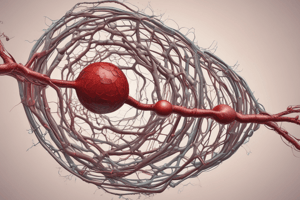Podcast
Questions and Answers
At what substrate concentration is the rate of reaction more sensitive?
At what substrate concentration is the rate of reaction more sensitive?
- Above Km
- More than 10 times the Km
- Below Km (correct)
- Equal to Km
What does the elasticity coefficient measure in an enzyme with Michaelis-Menten kinetics?
What does the elasticity coefficient measure in an enzyme with Michaelis-Menten kinetics?
- Temperature sensitivity
- Substrate specificity
- Rate of reaction
- Responsiveness to substrate concentration (correct)
What is the effect of increasing substrate concentration above the Km on enzyme activity?
What is the effect of increasing substrate concentration above the Km on enzyme activity?
- Nearly saturates the enzyme with substrate
- No effect on enzyme activity (correct)
- Increases enzyme activity
- Decreases enzyme activity
In what condition does an enzyme have an elasticity coefficient close to 0?
In what condition does an enzyme have an elasticity coefficient close to 0?
What can lead to the activation of AMP-activated protein kinase (AMPK)?
What can lead to the activation of AMP-activated protein kinase (AMPK)?
What determines if a reaction is near-equilibrium or far from equilibrium?
What determines if a reaction is near-equilibrium or far from equilibrium?
What is the primary effect of AMPK activation on metabolism in extra-hepatic tissues?
What is the primary effect of AMPK activation on metabolism in extra-hepatic tissues?
Which enzymes are highlighted as appropriate targets for regulating glycolytic flux?
Which enzymes are highlighted as appropriate targets for regulating glycolytic flux?
How does increased hexokinase activity affect glucose metabolism?
How does increased hexokinase activity affect glucose metabolism?
What is the main function of enzymes that catalyze reactions far from equilibrium in metabolic pathways?
What is the main function of enzymes that catalyze reactions far from equilibrium in metabolic pathways?
Which of the following statements about allosteric effectors is correct?
Which of the following statements about allosteric effectors is correct?
What is the relationship between the Hill coefficient and the effect of substrate concentration on reaction rate for allosteric enzymes?
What is the relationship between the Hill coefficient and the effect of substrate concentration on reaction rate for allosteric enzymes?
Which amino acid residues are typically phosphorylated in protein regulation?
Which amino acid residues are typically phosphorylated in protein regulation?
What is the role of regulatory protein subunits in enzyme regulation?
What is the role of regulatory protein subunits in enzyme regulation?
Which of the following statements about enzyme kinetics is true?
Which of the following statements about enzyme kinetics is true?
What is the key characteristic of proteins that undergo rapid turnover?
What is the key characteristic of proteins that undergo rapid turnover?
Which of the following statements about the N-end rule is true?
Which of the following statements about the N-end rule is true?
In a metabolic pathway, what is true about the net rates of all enzymes at steady state?
In a metabolic pathway, what is true about the net rates of all enzymes at steady state?
Which statement accurately describes the relationship between protein half-life and energy expenditure?
Which statement accurately describes the relationship between protein half-life and energy expenditure?
What is the significance of near-equilibrium and non-equilibrium steps in a metabolic pathway?
What is the significance of near-equilibrium and non-equilibrium steps in a metabolic pathway?




